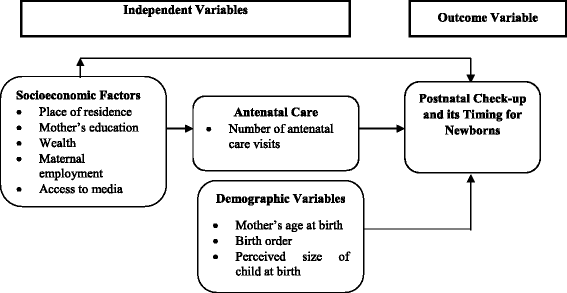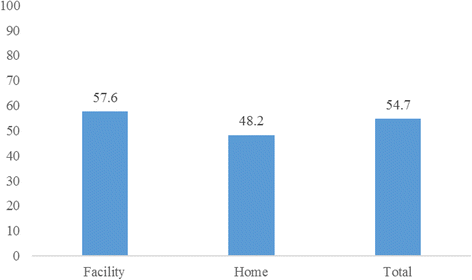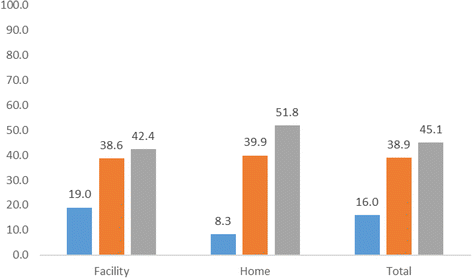Factors associated with postnatal care for newborns in Zambia: analysis of the 2013-14 Zambia demographic and health survey
- PMID: 29237406
- PMCID: PMC5729258
- DOI: 10.1186/s12884-017-1612-1
Factors associated with postnatal care for newborns in Zambia: analysis of the 2013-14 Zambia demographic and health survey
Abstract
Background: The importance of postnatal care cannot be overemphasised. Various studies undertaken worldwide have found that PNC is critical for the survival of newborns. However, in Zambia, despite much emphasis by the government and various international Organisations on the need for PNC, coverage continues to be low. This study attempted to assess the demographic and socio-economic factors associated with newborns' receipt of PNC and the timing of first PNC in Zambia.
Methods: Based on data from the 2013-14 Zambia Demographic and Health Survey (ZDHS), this study used bivariate, stepwise binary and multinomial logistic regression analyses to examine PNC for births at home and at health facilities.
Results: The results indicate that different factors influence the utilisation of PNC among home births, these include: place of delivery, mothers' exposure or access to media and having 4+ ANC visits. On the other hand, place of residence and mothers' access or exposure to media were found to be the determinants of PNC among facility deliveries. The results further indicate that among the home births, mothers' media exposure or access to media, having secondary or higher education, and having 4+ ANC visits during pregnancy increased the odds of having PNC within 48 hours. Furthermore, attending the first PNC 48 hours after delivery was determined by place of residence, media exposure and 4+ ANC visits. On the other hand, among the facility births, the timing of PNC within 48 hours, was influenced by the perceived size at birth of the newborn.
Conclusion: The study makes the following recommendations: more attention to be given to rural based women and newborns; encourage delivery at health facilities; more emphasis on the importance of ANC visits; and need to disseminate information through various media on the importance of PNC even in rural communities.
Keywords: Demographic and socio-economic factors; Facility births; Home births; Newborn; Postnatal care; Timing of first postnatal check-up; Zambia.
Conflict of interest statement
Competing interest
The authors declare that we have no competing interest.
Ethics approval and consent to participate
Although this data included human beings, this data analysis was secondary and permission was granted to us by DHS program for us to use the ZDHS dataset in particular the women’s (ZMIR61FL) stata data file. In addition, no potentially identifying information is part of this dataset
Consent for publication
No images, individual details or videos for clients’ data are part of this paper.
Publisher’s Note
Springer Nature remains neutral with regard to jurisdictional claims in published maps and institutional affiliations.
Figures
Similar articles
-
Magnitude and determinants for place of postnatal care utilization among mothers who delivered at home in Ethiopia: a multinomial analysis from the 2016 Ethiopian demographic health survey.Reprod Health. 2019 Nov 8;16(1):162. doi: 10.1186/s12978-019-0818-2. Reprod Health. 2019. PMID: 31703696 Free PMC article.
-
Factors associated with compliance with the recommended frequency of postnatal care services in three rural districts of Tanzania.BMC Pregnancy Childbirth. 2015 Dec 21;15:341. doi: 10.1186/s12884-015-0769-8. BMC Pregnancy Childbirth. 2015. PMID: 26689723 Free PMC article.
-
Factors associated with postnatal care utilisation in Rwanda: A secondary analysis of 2010 Demographic and Health Survey data.BMC Pregnancy Childbirth. 2016 May 31;16(1):122. doi: 10.1186/s12884-016-0913-0. BMC Pregnancy Childbirth. 2016. PMID: 27245586 Free PMC article.
-
Utilization of Postnatal Healthcare Services Delivered through Home Visitation and Health Facilities for Mothers and Newborns: An Integrative Review from Developing Countries.Indian J Pediatr. 2020 Mar;87(3):207-216. doi: 10.1007/s12098-019-03101-4. Epub 2020 Jan 3. Indian J Pediatr. 2020. PMID: 31900850 Review.
-
Community mobilization to strengthen support for appropriate and timely use of antenatal and postnatal care: A review of reviews.J Glob Health. 2021 Dec 30;11:04076. doi: 10.7189/jogh.11.04076. eCollection 2021. J Glob Health. 2021. PMID: 35003714 Free PMC article. Review.
Cited by
-
Association between antenatal care utilization pattern and timely initiation of postnatal care checkup: Analysis of 2016 Ethiopian Demographic and Health Survey.PLoS One. 2021 Oct 12;16(10):e0258468. doi: 10.1371/journal.pone.0258468. eCollection 2021. PLoS One. 2021. PMID: 34637481 Free PMC article.
-
Utilization of Postnatal Care Service in Indonesia and its Association with Women's Empowerment: An Analysis of 2017 Indonesian Demographic Health Survey Data.Matern Child Health J. 2022 Mar;26(3):545-555. doi: 10.1007/s10995-021-03324-y. Epub 2022 Jan 11. Matern Child Health J. 2022. PMID: 35013886 Free PMC article.
-
Trend analysis of multi-level determinants of maternal and newborn postnatal care utilization in Pakistan from 2006 to 2018: Evidence from Pakistan Demographic and Health Surveys.BMC Public Health. 2023 Apr 4;23(1):642. doi: 10.1186/s12889-023-15286-7. BMC Public Health. 2023. PMID: 37016374 Free PMC article.
-
Individual and community-level determinants of cervical cancer screening among Kenyan women: a multilevel analysis of a Kenya demographic and health surveys 2022.BMC Cancer. 2025 Jul 1;25(1):1067. doi: 10.1186/s12885-025-14474-5. BMC Cancer. 2025. PMID: 40597768 Free PMC article.
-
Predictors of Postnatal Care Service Utilization Among Women of Childbearing Age in The Gambia: Analysis of Multiple Indicators Cluster Survey.Int J Womens Health. 2020 Sep 9;12:709-718. doi: 10.2147/IJWH.S268824. eCollection 2020. Int J Womens Health. 2020. PMID: 32982475 Free PMC article.
References
-
- Save the Children. Surviving the First Day: State of the World’s Mothers 2013. May 2013. Save the Children, ISBN 1-888393-26-2, available at: http://www.refworld.org/docid/51a5ad654.html [accessed 20 January 2016].
-
- Sines E, Syed U, Wall S, Worley H. Postnatal Care: A Critical Opportunity to Save Mothers and Newborns. Washington DC: Population Reference Bureau; 2007.
-
- Barbara S. The Global Impact of Neonatal Infections. Clinics in Perinatology. 1997;24(1):1–21. - PubMed
MeSH terms
LinkOut - more resources
Full Text Sources
Other Literature Sources
Medical




